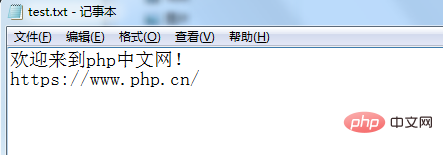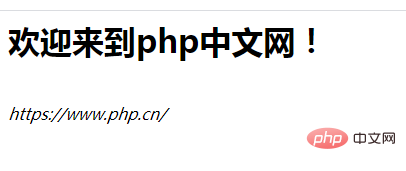PHP file operation: reading files line by line
Aug 03, 2021 pm 05:09 PMIn the previous article "php file operation - reading files character by character" we introduced a method of reading files: reading files character by character. In this article, we will show you another way to read files: read the file line by line. Let's see how to read the file content line by line and output it. Let's learn together.
There is a text file named "test.txt", the contents of which are:

How do we read the contents of the file line by line and Output? Simple, today we will introduce two methods to you.
Method 1: Using the fgets() function
Let’s take a look at the code example:
<?php
header("Content-Type: text/html;charset=utf-8"); //設(shè)置字符編碼
$handle = fopen('./test.txt', 'r'); //打開文件
if (!$handle) { //判斷文件是否打開成功
echo '文件打開失?。?amp;#39;;
}
while (false !== ($char = fgets($handle,1024))) { //循環(huán)讀取文件內(nèi)容
echo $char."<br>";
}
fclose($handle); //關(guān)閉文件
?>Output result:

Key function analysis:
fgets() function is used to read a line of data from an open file and accepts a required parameter $file (the file being opened) and an optional parameter $length (the number of bytes to be read); if the $length parameter is omitted, the default is to read Take 1k (i.e. 1024 bytes) length.
fgets() function encounters newline character, EOF (read to the end of the file) or reaches the specified length $length-1 Stop (the maximum length of the returned string is $length-1 bytes).
If we don't know how much data is in the file, we can use the filesize() function to get it, which can return the size of the specified file (number of bytes).
So the above code example can be modified:
<?php
header("Content-Type: text/html;charset=utf-8"); //設(shè)置字符編碼
$url = './test.txt';
$handle = fopen($url, 'r'); //打開文件
$size= filesize($url); //計(jì)算文件大小
if (!$handle) { //判斷文件是否打開成功
echo '文件打開失??!';
}
while (false !== ($char = fgets($handle,$size))) { //循環(huán)讀取文件內(nèi)容
echo $char."<br>";
}
fclose($handle); //關(guān)閉文件
?>The output result is the same as above.
Method 2: Using the fgetss() function
Let’s take a look at the code example:
<?php
header("Content-Type: text/html;charset=utf-8"); //設(shè)置字符編碼
$handle = fopen('./test.txt', 'r'); //打開文件
if (!$handle) { //判斷文件是否打開成功
echo '文件打開失敗!';
}
while (false !== ($char = fgetss($handle,1024))) { //循環(huán)讀取文件內(nèi)容
echo $char."<br>";
}
fclose($handle); //關(guān)閉文件
?>Output result:

Key function analysis:
The fgetss() function is similar to the fgets() function. Both can read a line of data from the open file. The difference is fgetss() The function filters out HTML and PHP tags from the data.
fgetss() function accepts one required parameter $file, two optional parameters $length and $tags. The parameters $file and $length are introduced in the fgets() function. You can learn more about them above. The parameter $tags is used to specify which tags are not to be removed. Let’s learn more about it through an example:

<?php
header("Content-Type: text/html;charset=utf-8"); //設(shè)置字符編碼
$handle = fopen('./test.txt', 'r'); //打開文件
if (!$handle) { //判斷文件是否打開成功
echo '文件打開失敗!';
}
while (false !== ($char = fgetss($handle,1024,"<h1>,<em>"))) { //循環(huán)讀取文件內(nèi)容
echo $char."<br>";
}
fclose($handle); //關(guān)閉文件
?>In the above code , we set the value of parameter $tags to "<h1>,<em></em>
</h1>", that is, we do not filter <h1></h1> and <em></em> tag, so the output result is:

Note: After operating the file, remember to use the fclose() function to close the file!
Okay, that’s all. If you want to know anything else, you can click this. → →Basic operation of PHP files
## Recommended: 《PHP interview questions summary (collection)》《php video tutorial》
The above is the detailed content of PHP file operation: reading files line by line. For more information, please follow other related articles on the PHP Chinese website!

Hot AI Tools

Undress AI Tool
Undress images for free

Undresser.AI Undress
AI-powered app for creating realistic nude photos

AI Clothes Remover
Online AI tool for removing clothes from photos.

Clothoff.io
AI clothes remover

Video Face Swap
Swap faces in any video effortlessly with our completely free AI face swap tool!

Hot Article

Hot Tools

Notepad++7.3.1
Easy-to-use and free code editor

SublimeText3 Chinese version
Chinese version, very easy to use

Zend Studio 13.0.1
Powerful PHP integrated development environment

Dreamweaver CS6
Visual web development tools

SublimeText3 Mac version
God-level code editing software (SublimeText3)

Hot Topics
 How do I stay up-to-date with the latest PHP developments and best practices?
Jun 23, 2025 am 12:56 AM
How do I stay up-to-date with the latest PHP developments and best practices?
Jun 23, 2025 am 12:56 AM
TostaycurrentwithPHPdevelopmentsandbestpractices,followkeynewssourceslikePHP.netandPHPWeekly,engagewithcommunitiesonforumsandconferences,keeptoolingupdatedandgraduallyadoptnewfeatures,andreadorcontributetoopensourceprojects.First,followreliablesource
 What is PHP, and why is it used for web development?
Jun 23, 2025 am 12:55 AM
What is PHP, and why is it used for web development?
Jun 23, 2025 am 12:55 AM
PHPbecamepopularforwebdevelopmentduetoitseaseoflearning,seamlessintegrationwithHTML,widespreadhostingsupport,andalargeecosystemincludingframeworkslikeLaravelandCMSplatformslikeWordPress.Itexcelsinhandlingformsubmissions,managingusersessions,interacti
 How to set PHP time zone?
Jun 25, 2025 am 01:00 AM
How to set PHP time zone?
Jun 25, 2025 am 01:00 AM
TosettherighttimezoneinPHP,usedate_default_timezone_set()functionatthestartofyourscriptwithavalididentifiersuchas'America/New_York'.1.Usedate_default_timezone_set()beforeanydate/timefunctions.2.Alternatively,configurethephp.inifilebysettingdate.timez
 How do I validate user input in PHP to ensure it meets certain criteria?
Jun 22, 2025 am 01:00 AM
How do I validate user input in PHP to ensure it meets certain criteria?
Jun 22, 2025 am 01:00 AM
TovalidateuserinputinPHP,usebuilt-invalidationfunctionslikefilter_var()andfilter_input(),applyregularexpressionsforcustomformatssuchasusernamesorphonenumbers,checkdatatypesfornumericvalueslikeageorprice,setlengthlimitsandtrimwhitespacetopreventlayout
 What is data serialization in PHP (serialize(), unserialize())?
Jun 22, 2025 am 01:03 AM
What is data serialization in PHP (serialize(), unserialize())?
Jun 22, 2025 am 01:03 AM
ThePhpfunctionSerialize () andunserialize () AreusedtoconvertcomplexdaTastructdestoresintostoraSandaBackagain.1.Serialize () c OnvertsdatalikecarraysorobjectsraystringcontainingTypeandstructureinformation.2.unserialize () Reconstruct theoriginalatataprom
 How do I embed PHP code in an HTML file?
Jun 22, 2025 am 01:00 AM
How do I embed PHP code in an HTML file?
Jun 22, 2025 am 01:00 AM
You can embed PHP code into HTML files, but make sure that the file has an extension of .php so that the server can parse it correctly. Use standard tags to wrap PHP code, insert dynamic content anywhere in HTML. In addition, you can switch PHP and HTML multiple times in the same file to realize dynamic functions such as conditional rendering. Be sure to pay attention to the server configuration and syntax correctness to avoid problems caused by short labels, quotation mark errors or omitted end labels.
 What are the best practices for writing clean and maintainable PHP code?
Jun 24, 2025 am 12:53 AM
What are the best practices for writing clean and maintainable PHP code?
Jun 24, 2025 am 12:53 AM
The key to writing clean and easy-to-maintain PHP code lies in clear naming, following standards, reasonable structure, making good use of comments and testability. 1. Use clear variables, functions and class names, such as $userData and calculateTotalPrice(); 2. Follow the PSR-12 standard unified code style; 3. Split the code structure according to responsibilities, and organize it using MVC or Laravel-style catalogs; 4. Avoid noodles-style code and split the logic into small functions with a single responsibility; 5. Add comments at key points and write interface documents to clarify parameters, return values ??and exceptions; 6. Improve testability, adopt dependency injection, reduce global state and static methods. These practices improve code quality, collaboration efficiency and post-maintenance ease.
 How do I execute SQL queries using PHP?
Jun 24, 2025 am 12:54 AM
How do I execute SQL queries using PHP?
Jun 24, 2025 am 12:54 AM
Yes,youcanrunSQLqueriesusingPHP,andtheprocessinvolveschoosingadatabaseextension,connectingtothedatabase,executingqueriessafely,andclosingconnectionswhendone.Todothis,firstchoosebetweenMySQLiorPDO,withPDObeingmoreflexibleduetosupportingmultipledatabas






